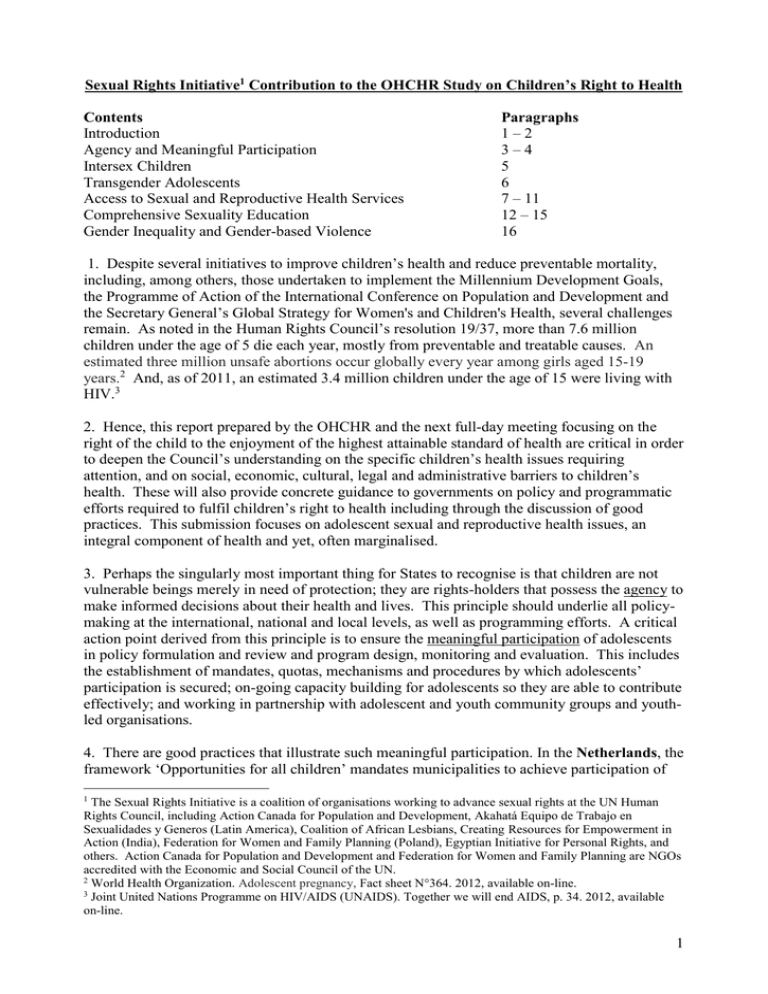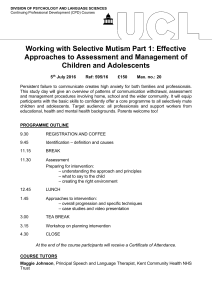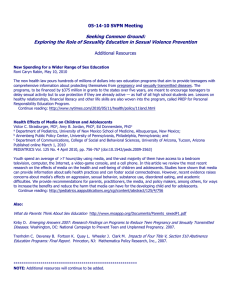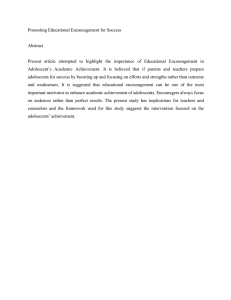
Sexual Rights Initiative1 Contribution to the OHCHR Study on Children’s Right to Health
Contents
Introduction
Agency and Meaningful Participation
Intersex Children
Transgender Adolescents
Access to Sexual and Reproductive Health Services
Comprehensive Sexuality Education
Gender Inequality and Gender-based Violence
Paragraphs
1–2
3–4
5
6
7 – 11
12 – 15
16
1. Despite several initiatives to improve children’s health and reduce preventable mortality,
including, among others, those undertaken to implement the Millennium Development Goals,
the Programme of Action of the International Conference on Population and Development and
the Secretary General’s Global Strategy for Women's and Children's Health, several challenges
remain. As noted in the Human Rights Council’s resolution 19/37, more than 7.6 million
children under the age of 5 die each year, mostly from preventable and treatable causes. An
estimated three million unsafe abortions occur globally every year among girls aged 15-19
years.2 And, as of 2011, an estimated 3.4 million children under the age of 15 were living with
HIV.3
2. Hence, this report prepared by the OHCHR and the next full-day meeting focusing on the
right of the child to the enjoyment of the highest attainable standard of health are critical in order
to deepen the Council’s understanding on the specific children’s health issues requiring
attention, and on social, economic, cultural, legal and administrative barriers to children’s
health. These will also provide concrete guidance to governments on policy and programmatic
efforts required to fulfil children’s right to health including through the discussion of good
practices. This submission focuses on adolescent sexual and reproductive health issues, an
integral component of health and yet, often marginalised.
3. Perhaps the singularly most important thing for States to recognise is that children are not
vulnerable beings merely in need of protection; they are rights-holders that possess the agency to
make informed decisions about their health and lives. This principle should underlie all policymaking at the international, national and local levels, as well as programming efforts. A critical
action point derived from this principle is to ensure the meaningful participation of adolescents
in policy formulation and review and program design, monitoring and evaluation. This includes
the establishment of mandates, quotas, mechanisms and procedures by which adolescents’
participation is secured; on-going capacity building for adolescents so they are able to contribute
effectively; and working in partnership with adolescent and youth community groups and youthled organisations.
4. There are good practices that illustrate such meaningful participation. In the Netherlands, the
framework ‘Opportunities for all children’ mandates municipalities to achieve participation of
1
The Sexual Rights Initiative is a coalition of organisations working to advance sexual rights at the UN Human
Rights Council, including Action Canada for Population and Development, Akahatá Equipo de Trabajo en
Sexualidades y Generos (Latin America), Coalition of African Lesbians, Creating Resources for Empowerment in
Action (India), Federation for Women and Family Planning (Poland), Egyptian Initiative for Personal Rights, and
others. Action Canada for Population and Development and Federation for Women and Family Planning are NGOs
accredited with the Economic and Social Council of the UN.
2
World Health Organization. Adolescent pregnancy, Fact sheet N°364. 2012, available on-line.
3
Joint United Nations Programme on HIV/AIDS (UNAIDS). Together we will end AIDS, p. 34. 2012, available
on-line.
1
youth aged 13-25 years in local civil society and policy issues that concern them. A variety of
local initiatives is supported by local municipalities, ranging from local youth councils to young
ambassadors, youth mayors and other youth participation projects. In India, the National AIDS
Control Organisation and the Ministry of Social Justice and Empowerment have worked with
The YP Foundation, a youth-led organisation, obtaining technical assistance on how to work
more effectively with adolescents and youth, and inviting them to the drafting committees of the
2010 National Strategic Framework for HIV Prevention for Adolescents and Young People and
the 2006 National Drug Awareness Campaign on substance abuse.
5. The principle of agency also applies to medical interventions performed on intersex children.
Many intersex children are subjected to sexual reassignment surgery and hormone therapy in
their infancy and early childhood, without their consent, despite these interventions rarely being
medically necessary4. Thus, this practice may be considered medical abuse and is in conflict
with Article 12 of the Convention on the Rights of the Child on the right of children to have
their views taken into consideration in all matters affecting them. In Colombia, legal
jurisprudence5 on this issue recognises any medical intervention to change gender identity
without the child’s consent to be in contravention of the child’s autonomy and dignity.
Additionally, some intersex variations are diagnosed during or after puberty; due to prevailing
binary definition of gender, family and societal pressures force these adolescents to undergo
medical procedures.
6. In the case of transgender adolescents, in most countries, gender reassignment therapy is only
available to those aged 18 and older. This denial of an essential service contradicts the
principles of agency and self-determination, and is a violation of children’s rights to life and
development (CRC Article 6), to preserve their identity (Art. 8), to be heard in matters affecting
them (Art. 12) and to health (Art. 24). In the absence of access to transitional health services,
transgender adolescents will resort to harmful practises such as unregulated hormone therapy
and silicone pumping (the injecting of liquid silicone into a body part). However, in some
countries, like Argentina, a recent law permits transgender minors to access comprehensive
hormonal treatment after providing informed consent, and surgical intervention after obtaining
the agreement of competent judicial authorities based on a consideration of the evolving
capacities and best interest of the child. Further, transphobia and prejudice deter transgender
adolescents from accessing health services, including sexual and reproductive health services; in
particular, trans boys are deterred from accessing reproductive health services, including
abortion, and services for survivors of sexual and gender-based violence. Transphobia,
harassment and violence can force adolescents to drop out of school and lead to homelessness,
which pushes them into sex work and increases the risk of sexually transmitted infections and
HIV.
7. Adolescents’ access to sexual and reproductive health services such as contraceptives,
abortion, testing and treatment for sexually transmitted infections and HIV is a critical area of
concern, as several barriers exist to such access. Foremost, social and cultural taboos surround
adolescent sexuality in several societies and create a culture of silence on the subject. This
means that adolescents may not have knowledge of the location of health centres providing
sexual and reproductive health services and the range of services that are available; such
information must be adequately advertised at the community level. It also means that for
adolescents, sexual and reproductive health is associated with a higher degree of need for
4
Haas, K. Who will make room for the intersexed? at p.42. American Journal of Law and Medicine, Vol. 30,
Number 1. 2004, available on-line.
5
Gonzalez v. Colombia (1995) and Ramsos v. Colombia (1999)
2
privacy than other health issues and they may not seek the support of adults in accessing sexual
and reproductive health services. A particular concern is the affordability of such services,
including not only the direct cost but also related costs such as transportation, loss of income and
opportunity costs. Moreover, it is important to ensure the availability of sexual and reproductive
health services within a reasonable geographic distance and within physically accessible
facilities.
8. The above-mentioned taboos also manifest in the form of stigma and discrimination at the
hands of service providers, making adolescents reluctant to access sexual and reproductive
health services, particularly unmarried adolescents. Besides their age and marital status, the
stigma and discrimination is exacerbated, and barriers perpetuated, based on gender, sexual
orientation, disability, HIV status and socio-economic status of adolescents. Besides changing
societal attitudes, targeted training for health personnel and service providers is necessary so that
health services meet the needs of all adolescents without prejudice, discrimination or coercion,
and with full respect for their privacy. Further, sexual and reproductive health services provided
through ‘family planning’ or ‘maternal and child health’ programmes may be mandated to serve
those who are married; in either case, these services may be known by names that lead
adolescents to believe that their needs will not be served there.
9. In order to address several of the aforementioned barriers a multitude of youth-friendly health
centres are being developed throughout the world. Good practices include the example of
Thailand, where the Ministry of Public Health developed Health Promoting Hospitals,
committed to health promotion and to making health services more user-friendly. The
Department of Health introduced Friend Corners outside school and college hours in local
shopping malls and community housing areas. Adolescents trained as peer counsellors were the
first point of contact, and health staff were also on hand to provide counselling or basic primary
care or to refer adolescents to specialised services as necessary. The Friend Corner web site
combined music, fashion and health information, and made information accessible in an
attractive way. In Tunisia, reproductive health services, counselling and referrals were
integrated into existing student health centres. In a collaboration between the National Office of
Family Planning and Population, Student Health, Jeunes Medecins Sans Frontiere and the
Tunisian Association of Family Planning, at least one health or family planning centre was set
up in every major town, offering services for young and unmarried people. According to the
World Health Organization:
Adolescent friendly health services can be delivered in health centres, in the community, through
outreach services or at school. Hospital or clinic based services can become more adolescent
friendly. Community settings include services provided at community or youth centres, in
shopping malls or even over the Internet. Outreach services are needed in cities to contact
adolescents who do not attend clinics and those, like street children, who are marginalised.
Outreach services in rural areas can be devised to reach young people living in isolated
communities. Schools offer a critical entry point to bring services to young people who are in
school. Young workers, including adolescents, can be reached with health education or screening
services targeted on the workplace. Services can be located anywhere where young people go –
no single setting should become the only model.6
10. Apart from social, cultural and economic barriers, there exist different legal and
administrative restrictions to adolescents’ access to sexual and reproductive health services.
Adolescents may need to obtain consent from their parent or guardian for medical treatment in
general – as is the case in several States – or specific sexual and reproductive health services.
World Health Organization. Adolescent Friendly Health Services – An Agenda for Change, p.36. 2002, available
on-line.
6
3
For example, in Haiti, those under the age of 18 require parental consent for HIV testing and
counselling, and in Zimbabwe, unmarried adolescents under the age of 18 may not access
services and information on contraception and STI prevention without the consent of a parent or
guardian. Parental consent is required to obtain legal abortion services in India, Poland, Jamaica
and Barbados; spousal consent is required in Republic of Korea, Japan, Morocco and Maldives;
and both are required in Taiwan, Kuwait, Saudi Arabia and Equatorial Guinea. Fear and stigma
often deter adolescents from obtaining such consent and they may forego seeking information or
accessing a service, or seek out back-street providers. Further, statutory rape laws and other
laws prescribing minimum age of consent for sexual activity – if too high and not taking into
consideration the evolving capacities of adolescents – act as a barrier in accessing sexual and
reproductive health information and services.
11. Laws must provide sufficient protection to children and adolescents without restricting the
exercise of their rights. This can be done when States “develop and implement, in a manner
consistent with adolescents’ evolving capacities, legislation, policies and programmes to
promote the health and development of adolescents…”.7 Examples of good practices include
South Africa, where the Children’s Act (2005) regulates, inter alia, consent to health services.
A child of at least 12 years does not require parental consent in order to access contraceptives,
provided adequate medical advice is given and the child examined to determine if there is any
medical reason why a particular contraceptive should not be used. Similarly, the Choice on
Termination of Pregnancy Act (1996) recognises the capacity of a minor to consent to abortion
on her own without the consent of a parent or guardian. The health service provider must advise
the adolescent girl to consult with a parent, guardian or family member, but she may choose not
to do so. Approaches that do not impose restrictions for adolescents, and direct a service
provider to consider the child’s best interests, enable adolescents to access the information and
services they need, and also allow for detection of sexual abuse. In Uganda, the National Policy
Guidelines for HIV Counselling and Testing do not prescribe a minimum age for consent, rather
children have the right to consent when they “can understand and cope with the results basing on
the counselor’s discretion”; Brazil has a similar policy.
12. Children and adolescents must be provided comprehensive sexuality education, according to
their evolving capacities. It is recognised as a basic human right of children in both the annual
report of Special Rapporteur on the right to education to the UN General Assembly in 2010 and
General Comment No. 4 of the Committee on the Rights of the Child.
In light of articles 3, 17 and 24 of the Convention, States parties should provide adolescents with
access to sexual and reproductive information... In addition, States parties should ensure that they
have access to appropriate information, regardless of their marital status and whether their parents
or guardians consent. It is essential to find proper means and methods of providing information
that is adequate and sensitive to the particularities and specific rights of adolescent girls and boys.
To this end, States parties are encouraged to ensure that adolescents are actively involved in the
design and dissemination of information through a variety of channels beyond the school,
including youth organizations, religious, community and other groups and the media. 8
13. Effective sexuality education must go beyond biology to educate children and adolescents
about gender equality, healthy and positive aspects of sexuality, relationships, gender-based and
sexual violence, sexual and gender diversity, healthy emotive processes, informed consent and
human rights. It should promote empowerment and autonomy by including structured
7
Committee on the Rights of the Child. General Comment No. 4 (2003): Adolescent health and development in the
context of the Convention on the Rights of the Child. Para 16.
8
Committee on the Rights of the Child. General Comment No. 4 (2003): Adolescent health and development in the
context of the Convention on the Rights of the Child. Para 28.
4
opportunities for adolescents to practice life skills they will need to be able to make free and
informed choices about their sexual lives and to explore their attitudes and values. Such
education must be free of and aim to eliminate stereotypes, discrimination, and stigma; respect
the evolving capacities of children and adolescents; and be tailored to meet the specific needs of
particular groups e.g. children with disabilities and those living on the streets. UNESCO’s
guidelines9 are a valuable resource for States for designing sexuality education programmes.
14. Further, it is important to recognise that certain groups such as girls and young women,
those with disabilities and the poor face a disproportionate burden of ill-health and/or rights
violations related to their sexual and reproductive rights and ensure that comprehensive
sexuality education programmes are reaching them, including through implementation in both
formal and informal settings. Peer education programs should be supported; with design aspects
of long-term training, regular supervision and community involvement these are found to be
effective in empowering adolescent educators and reaching marginalised communities of
adolescents.
15. A growing number of governments around the world are confirming their commitment to
sexuality education. In August 2008, health and education ministers from across Latin
America and the Caribbean came together in Mexico City to sign a historic declaration
affirming a mandate for national school-based sexuality and HIV education throughout the
region. The declaration advocates for strengthening comprehensive sexuality education and to
make it a core area of instruction at both primary and secondary schools in the region, and
commits to implement and/or strengthen multi-sector strategies of comprehensive sexuality
education and promotion and care of sexual health, including HIV prevention. Good practices at
the national level include Pakistan where the Ministry of Education supported an NGO, Aahung
to pilot their comprehensive sexuality education curriculum in public schools across four
districts in Sindh Province. This resulted in the training of 130 teachers from 31 government
schools in Karachi, who used the curriculum to teach 11,250 students. In Cameroun, the
Ministry of Secondary Education supported Femmes, Santé, et Développement (FESADE) to
pilot their 21-module curriculum and train teachers in 50 schools in two districts, paving the way
for widespread adoption.
16. Gender inequality and gender-based violence constitute a significant barrier to girls’ health,
particularly their sexual and reproductive health. Girls continue to be forced into early marriage
and childbearing, and non-consensual sexual relations; denied access to schooling, higher
education and vocational training, adequate nutrition and healthcare, and sexual and
reproductive health information. Harmful practices based on traditional and/or cultural values
prevail in most societies of the world, for example, female genital mutilation/cutting, breastironing, force-feeding and so on. Wide-ranging public education programmes are necessary to
eliminate gender stereotypes, change restrictive gender norms and promote intolerance of
gender-based violence. Laws must prohibit gender-based discrimination and all forms of
gender-based violence including the ones mentioned above, and their enforcement must be
prioritised. Policies and programmes must be developed with the participation of girls and must
utilise a gender perspective in order to benefit girls, for example, designing HPV vaccination
programmes on the basis of informed consent, providing adequate and segregated fully
functioning sanitary facilities in schools, and enabling retention in school of adolescent girls that
get pregnant.
9
UNESCO. International Guidelines on Sexuality Education: An evidence informed approach to effective sex,
relationships and HIV/STI education. 2009, available on-line.
5





